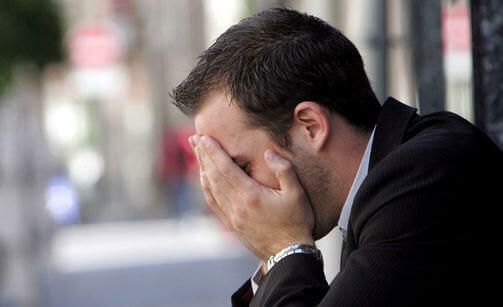Obsession
 Obsession is an obsessive, involuntary thought, idea or idea that occurs after an indefinite period of time. The person is fixed on these thoughts, causing him distress( prolonged, emotional, negative stress), but they can not get rid of them. Obsessions can be combined with compulsions( obsessive behavior) or exist in a pure form. Against the background of obsessive states, phobias can develop( irrational fears).
Obsession is an obsessive, involuntary thought, idea or idea that occurs after an indefinite period of time. The person is fixed on these thoughts, causing him distress( prolonged, emotional, negative stress), but they can not get rid of them. Obsessions can be combined with compulsions( obsessive behavior) or exist in a pure form. Against the background of obsessive states, phobias can develop( irrational fears).
Obsessia - the history of
For the first time the disease was described by Felix Plater in 1614, then J.-E.D. Eskirol in 1834 described obsessions and compulsions with phobias.
Since 1858 I.M.Balinsky, working on obsessions, noted that all obsessions have a common - it is alien to consciousness, and introduced the term obsession.
In 1860, the disease gives a description of B.O.Morel, who described the individual symptoms of obsessive disorder, and in 1868, V. Grizinger gave a description of fruitless wisdom.
In 1877 it was noted by KF O. Westfal that the obsessions are not expelled from consciousness, and the disorder of thinking is hidden in obsessive states.
The year 1892 was marked by the successful application by V. M. Bekhterev of psychotherapy during the obsessions. His pupil, A. Ivanov-Smolensky, believed that obsessions are obsessions of excitement.
Obsession -
classification Many researchers opposed the classification of obsessions, as this is difficult due to the connections of compulsions and phobias. But still an attempt was made to classify.
KT Jaspers shared the obsessions on:
- abstract( without the altered affect) - an obsessive account of arithmomania, decomposition according to syllables of words, fruitless wit, obsessive memories( individual cases);
- shaped( when accompanied by anxiety or fear) - obsessive drives, obsessive doubts, obsessive memories, capturing ideas.
Lee Baer divided the disease into such groups: aggressive inappropriate thoughts, inappropriate thoughts about libido, religious blasphemous thoughts.
AM Svyadoshch developed this classification:
- Elementary, which arise due to a superstrong stimulus. For example, the occurrence of fear of a train accident;
- Cryptogenic, the occurrence of which is unknown.
AG Ivanov-Smolensky obscession divided into two groups. In the intellectual sphere, these obsessions are excitement: obsessions, ideas, memories, associations, desires. In the emotional sphere, these are obsessive fears.
Lee Baer believes that the obsession is more characteristic of obsessive-compulsive disorder. It is established that 78% of people with OCD suffer from obsessions, 10% are burdened with obscene obsessional sexual drives. With neuroses, a third of people with obsessions have a depressive or hypochondriacal syndrome.
Obsession - reasons for
At the moment there are no clear reasons for explaining the origin of the obsession, because it is complicated by mental disorders, but there are several hypotheses: biological, genetic, psychological.
Biological includes diseases, as well as anatomical features of the brain and the autonomic nervous system. First of all, this occurs when the exchange of neurotransmitters, norepinephrine, serotonin, dopamine and GABA is disturbed.
Genetic includes increased genetic concordance.
Psychological theory includes: accentuation of personality, as well as character;Sexual, family, and also production factors;sociological and cognitive theories( strictness in religious education).
Obsessions increase during breastfeeding, after the flu, after childbirth, as well as physical illness. One of the reasons for the obsessions is the genetic mutations found in the hSERT serotonin gene. It is established that there is a direct relationship between the lack of serotonin and the appearance of OCD.
Studies conducted with odnoyaytsovymi twins, indicate hereditary factors of obsessions. And people with OCD are more likely to have relatives with the same disorder.
Obsessions can be directly related to social phobia, with a depressed state, as well as PTSD.
Obsessions are manifested as obsessive images, thoughts, fears and desires. There can be an obsession about personal impurity.
Obsessions and compulsions of often go together, they are characterized by special rituals, helping at the time to get rid of obsessions.
Obsessive states can be observed of different types. Their occurrence can be sudden or short-term, as well as chronic.
Distinctive features of obsessions:
Conservation of consciousness, lack of the will of the individual and at the same time having attempts to fight against obsessions and criticism against him. A distinctive feature is both active and passive type of struggle. Active struggle is accompanied in spite of the obsession, with passive switching to other activities, trying to avoid obsessive situations.
Obsessions are alien to thinking and are interrelated with a depressive mood, anxiety, and intellect and logical thinking are not affected.
A distinctive feature of the disease is a painful, fruitless wiserness, for which an empty, barren verbosity with criticism to this condition is characteristic. Questions that torture patients are metaphysical concepts, moral, religious. For example, a woman on the street is concerned that nothing and no one fell at her feet from the window. And if it falls, then who will it be? Man or woman? How exactly he will fall: on his feet or his head. If what I have to do is to break to death? Call for help people or hide? Will they blame me for this? Will I remain innocent?
Obsessive thinking can contribute to an obsessive world outlook that is alien to his consciousness and contradicts morality, as well as other principles, but he can not get rid of it.
Obsessive ideas distract the patient from focusing on the object of meditation.
Obsessive memories are desires for the reproduction of various minor events. A very close to this phenomenon is onomatomania, as an obsessive reproduction of words.
The next variant of obsessions is obsessive doubts, which are expressed in the indecisiveness of the individual and uncertainty about the correctness of the actions performed.
Obsessive fears are expressed in anxiety and insolvency to do something familiar, automated or professional.
For example, a sick notary had a fear that he could do something that might lead him to court, so closing the office, he asked to hide the keys from him, since he did not trust himself.
Obsessive cravings are manifested in a dangerous, pointless and indecent act.
Surprising representations are characterized by improbable, and also improbable ideas representing for the patient the valid events. For example, a sick son died, and after a while it seems to him that he was buried alive. Hallucinatory obsessions tortured the patient so much that he went to the cemetery and listened to the screams from the grave.
Obessia is characterized by contrasting ideas, as well as blatant thoughts, contrary to the ethical principles of the individual. For example, an ecclesiastic minister at ceremonies of religious content represented indecent things.
The structure of the obsessive syndrome includes emotion disturbances. This is most common for figurative obsessions. With moderate obsessions, the subdepressive background, sense of inferiority, and also uncertainty are inherent. Can join asthenia, neurosis.
The perceptual properties of obsessions are manifested in the elements of depersonalization, characterized in the syndrome of a mirror. Patients are afraid to look in the mirror, for fear of a crazy look, or look away from the interlocutor for the same reason.
At the peak of obsessions may be hallucinations, but they are characteristic in the presence of severe phobias. There may be disorders of taste, as well as smell, illusions are possible.
Obsession - symptoms
Skin covers can turn pale or blush, cold sweats, tachycardia, bradycardia, anxiety shortness of breath, polyuria, frequent dizziness, increased peristalsis, fainting. This is just a small list of symptoms.
Obsession - signs
At obsessions the character of the patient and the person as a whole change. Patients become suspicious, anxious, impressionable, indecisive, uncertain, timid, timid, shy.
Often an obsessive syndrome arises with such diseases as psychosis or schizophrenia. The distinctive features of schizophrenia are suddenness, incomprehensible content, unmotivated.
Obsession - treatment of
How to get rid of obsessions? Treatment of obsessions is divided into etiological and pathogenetic. Etiological treatment removes the causes that hurt the patient. Pathogenetic treatment effectively affects the pathophysiological links of the brain. Of course, pathophysiological treatment is considered the leading treatment for the obsessions.
Cognitive-behavioral psychotherapy is used as a psychotherapeutic aid. The effect of it is good.
The next option is the exposition psychotherapy, psychoanalysis, methods of suggestion, hypnosis, as well as the method of autosuggestion and autogenic training proved to be quite good.
In obessiyah recommended full rest, enthusiasm for classes, travel, occupational therapy, supply of the body with vitamins and minerals.
Medication includes tranquilizers( "phenazepam", "clonazepam" "Diazepam"), antidepressants( Sertraline, Fluoxetine, Citalopram), neuroleptics( Risperidone, Olanzapine, Quetiapine).
Physiotherapy is shown: warm baths, a cool compress on the head, a ventilated room, wiping, as well as dousing with water, swimming in sea waters, darsonvalization, electrophoresis.
More articles on the topic:
• Erythrophobia • Oniomania



